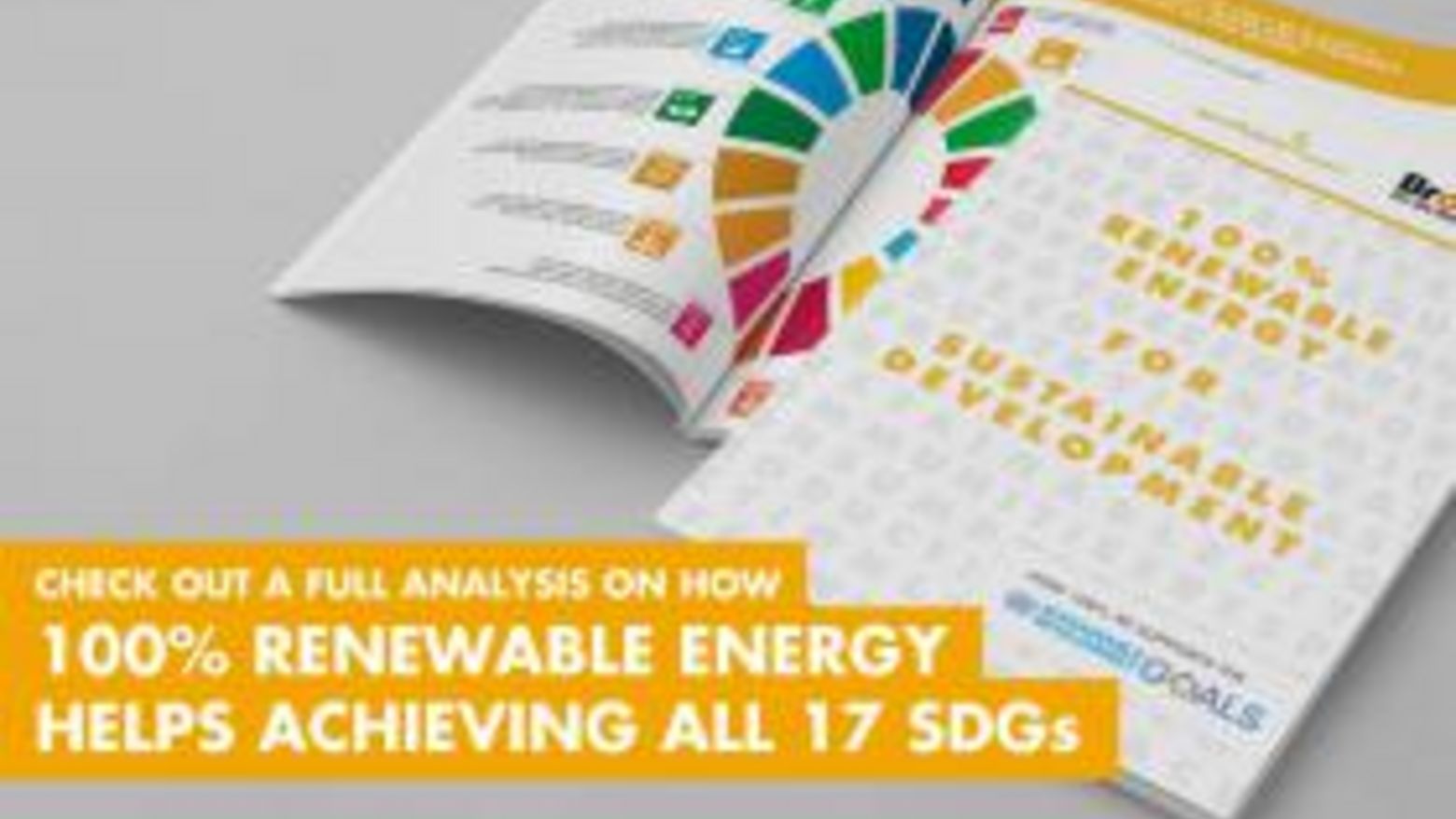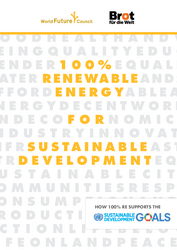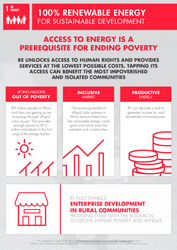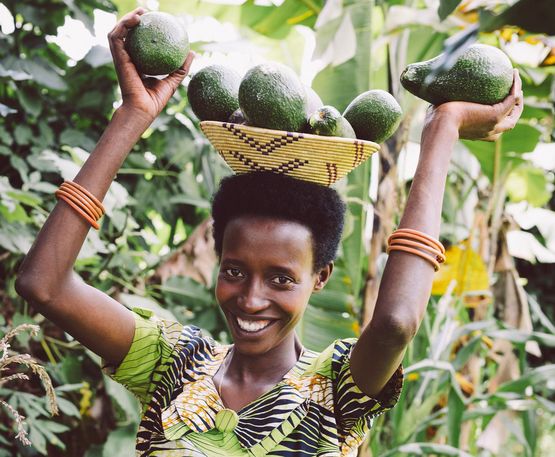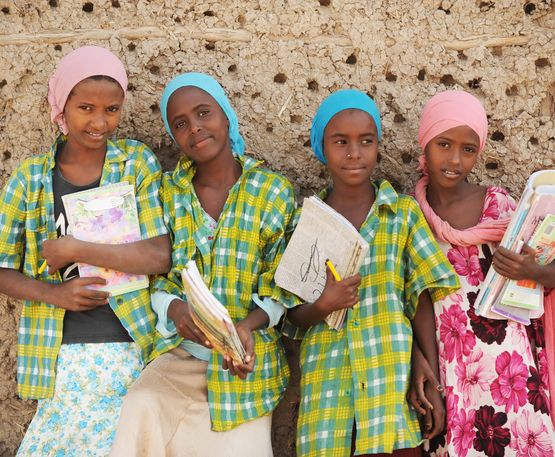Sustainable development can only be reached by transitioning to 100% Renewable Energy (RE). In fact, 100% RE is more than just replacing fossil fuels with renewable sources in today’s energy system. It can serve as a mean for socioeconomic development and help create a just society for today’s and future generations. Hereby, it supports the implementation of each sustainable development goal. You want to know how? Let´s have a look.
To end poverty in all its forms everywhere (SDG1), reduce vulnerabilities and ensure equal opportunities to economic resources, the access to energy is a prerequisite. Access to modern energy services is regarded as a prerequisite for a life of dignity. This applies to substantive human rights such as access to clean water (SDG6), good nutrition (SDG2), health (SGD3), safe shelter (SDG11) and education (SDG4).
This is why SDG 7 urges us to “ensure access to affordable, reliable, sustainable and modern energy for all”. This means nothing less than implementing 100% Renewable Energy. It embraces the necessary paradigm shift and is the fastest, cheapest and indeed only way to “leave no one behind”.
Producing energy from natural powers such as sun and wind is possible everywhere. Their modular and decentralized nature allows for great flexibility. Even the smallest communities can have a small solar system installed or an off-grid mini-grid and gain control over their own energy supply, without the need to abide to large corporations in charge of large, centralized energy distribution. In big cities, renewables can provide basic services such as reliable electricity for vulnerable people living in slums and clean fuel to reduce air pollution (SDG11 & 3). Hereby renewable energies reduce inequalities (SDG 10), especially between urban and rural population. They allow paying attention to the needs of disadvantaged and marginalized populations, especially women and children who suffer most from insufficient basic service in their homes (SDG5). A 100% RE approach enables all countries to depend only on the most equitably distributed energy of all: abundant and clean renewable energy, distributed within their own borders, close to their communities and accessible by everyone.
To ensure access to water and sanitation for all (SDG6), “water-friendly” technologies from a life-cycle perspective are essential. Solar PV or wind could withdraw up to 200 times less water than a coal power plant to produce the same amount of electricity. Further, renewables are the most resilient and low cost option to access, treat and pump water especially in hot, dry regions. And here, we haven’t even touched upon the impact of fossil fuel extraction and transportation on the quality of water resources, the health of aquatic ecosystems and climate change. Clean water is also essential to end hunger, achieve food security and improved nutrition as well as promote sustainable agriculture (SDG2).
Transforming our energy system to 100% RE allows the reduction of air pollution and brings down harmful emissions that cause diseases and climate change (SDG 13). Renewables therefore enhance health and well-being for millions of people (SDG3) who need treatment and cooled medication in hospitals and rural health centres, suffer from air pollution caused by the transport sector or coal-fired plants or those women and children who cook on charcoal and suffer from indoor smoke (SDG5). With fossil fuels being a major driver of global warming, reaching 100% RE as soon as possible is a prerequisite to limit it to 1.5C degrees (SDG13).
Already today, renewables are the cheapest option for electricity production in many regions across the world, especially in isolated places. Thanks to falling prices for the equipment, the fact that wind and sun is for free and therefore renewables have practically zero marginal costs but also thanks to fact that renewables have no external costs, renewables are the most competitive source to produce energy. This is crucial to provide energy to all (SDG7), eradicate poverty (SDG1), achieve decent work for all (SDG8) as well as build resilient infrastructure, promote sustainable industrialization and foster innovation (SDG9).
Renewable Energies can be installed, managed and owned by everybody. Hereby, 100% RE is also an opportunity to enhance procedural rights such as inclusive participation and access to information for of all (SDG1, 4, 5, 10). Further this means that, with the right finance mechanism, every citizen and community can not only benefit from energy services (for SDG 3,4,6 and 7) but also from becoming an energy producer and hereby drive innovative business models (SDG8&9). Implementing 100% RE can therefore unleash opportunities especially for entrepreneurs and build up new industries (SDG9). Thanks to their decentralised character, renewables create diverse and good quality job and income opportunities in every country in urban as well as in rural areas. Therefore they “leave no one behind”. In fact, renewables create more jobs per unit of energy than any other energy source (SDG 8).
As renewables technologies produce energy from abundantly available resources used in efficient and often smart infrastructures, a 100% RE approach ensures sustainable consumption and production patterns (SDG12). Using renewable electricity also for cooking, we could decrease the ecological burden on our ecosystem caused by unsustainable use of biomass. Also expanding use of biogas from organic waste helps achieving the reduction of waste, in particular food waste.
By transitioning to 100% RE, we could mitigate ocean acidification and conserve marine ecosystems as they are heavily impacted by oil and gas exploration and nuclear energy production (SDG14). The same is true for life on land (SDG15). A major and rapid uptake of RE is the only sustainable solution to limit the increasing effects of climate change on the ecosystems and biodiversity, whose delicate equilibrium is greatly disrupted even by the smallest changes in average temperature. Further, ecosystem disturbance and degradation resulting from direct or indirect effects of extraction can be stopped by adopting a 100% RE approach. Renewables have the least life-cycle ecological impact per kWh of energy produced.
Finally, a world powered with 100% RE would be a more peaceful, secure and fair place for all (SDG16). While there are certainly diverse causes for the existence of conflicts, many of them are connected to access to fossil fuel resources and infrastructure. By transitioning to 100% RE, countries, islands cities and communities can improve their energy autonomy and break free from oil, gas, coal and uranium imports which often cause geopolitical tensions or armed conflicts. As many communities across the world show, transitioning to 100% RE can also support better institutions and governance structures through what is known as energy democracy. Renewables provide the chance for all people to engage and benefit from energy as a common good (SDG10). They hereby help to develop effective, accountable and transparent institutions and broaden and strengthen participation (SDG16).
RE development requires strong cross-sectoral, transregional and transnational partnerships as well as a continuous exchange of solutions, best practises and lesson learnt. In fact, the effective and rapid implementation of a 100% RE target depends on a strong collaboration between local actors and other regional, national and international stakeholders and governments. Therefore, strengthening renewable energy partnerships (SDG17) goes hand in hand with improving the partnerships necessary for the implementation of the SDGs.
The wide-range of co-benefits linked to RE development reveal once again the strong interdependency among all aspects of sustainable development. In light of the vast benefits related to RE development and its instrumental role in supporting sustainable development, it becomes essential that policy makers and development organizations embrace the 100% RE message and integrate a 100% strategy into their development plans. The key policy recommendations to achieve this are:
1. Set a 100% RE target and embed it across policy areas and in SDG processes
2. Set a “leave no one behind” approach to energy policy
3. Ensure adequate civil society participation and capacity building
4. Enhance renewable energy in the cooking sector
5. Prioritize energy efficiency
6. Use fossil subsidies for funding
7. Strengthen change agents and pioneers


